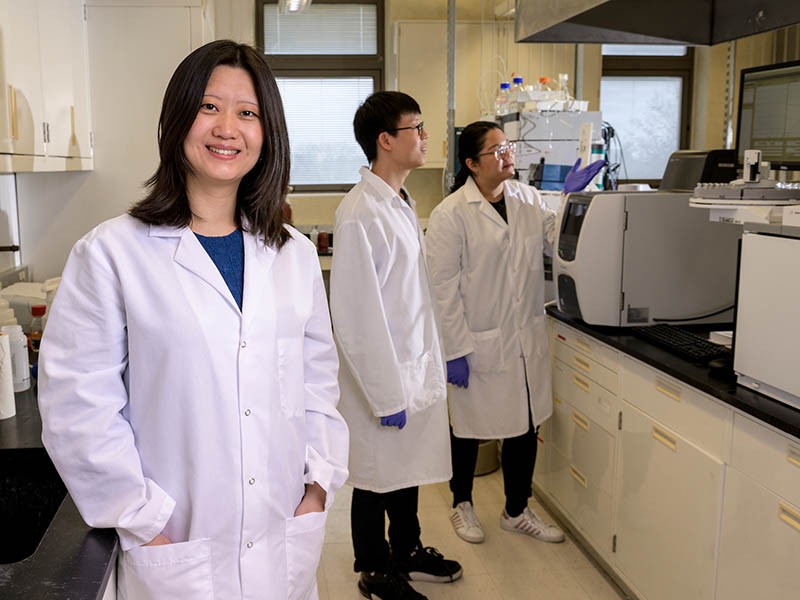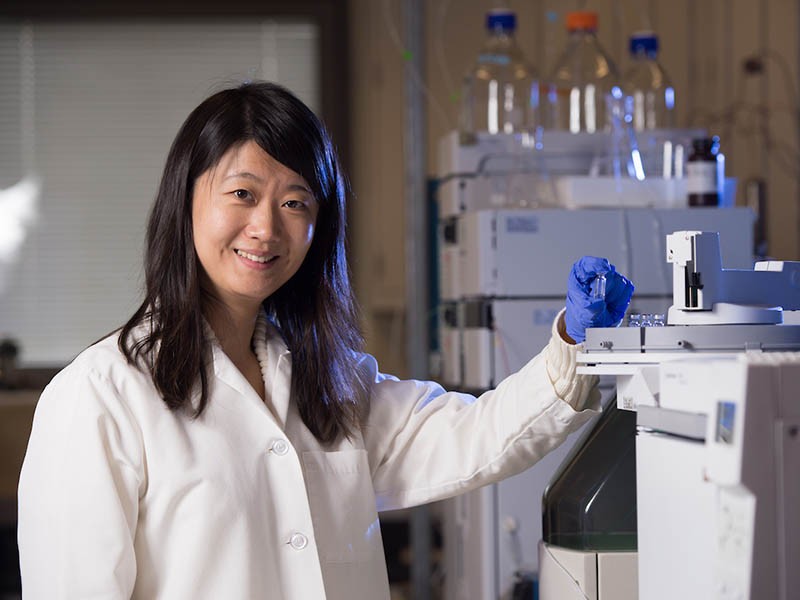Center for Human-Environmental Systems (CHES)
Founded in 2022, the Center for Human-Environmental Systems (CHES) will integrate and advance interdisciplinary research and scholarship at the nexus of people and planet.
CHES will reach across disciplines, bringing in faculty members from the College of Liberal Arts & Sciences and the Charles Widger School of Law, in addition to the College of Engineering (COE), to advance technologies and solutions that mimic natural processes and promote restorative impacts upon the Earth’s interconnected systems.
CHES has 12 active grants, funded by the National Science Foundation, Department of Defense, National Institutes of Health, Environmental Protection Agency, and Philadelphia Water Department. With a research focus on environmental justice in addition to biomimetic materials and sensing technologies, CHES aims to elevate the profile of the COE while furthering our commitment to engineering for the greater good.
CHES AT A GLANCE
12
Active Grants
7
Funding Sources
6
Faculty Members
5
Laboratories
3
Colleges
CURRENT RESEARCH
CHES has 12 active grants with a total of $4.5 million in funding. Collectively, the faculty team is investigating a range of topics that are relevant to the human-environment systems in bioremediation, novel material design and human mobility in a changing climate. Below are a few examples.
Sponsor: Department of Defense
Status: Mid-term; transitioning to the next stage through field demonstration
Description: High concentrations of insensitive high explosives (IHEs) are commonly found in soil at Department of Defense (DoD) testing and training ranges, posing a significant safety threat to military personnel and surrounding communities. Many IHEs are highly water-soluble and can easily migrate from the soil and thereby contaminate groundwater. In this project, we tailor pyrogenic carbonaceous matter (PCM; e.g., activated carbon) to effectively sequester IHEs and hydroxide ions on PCM surfaces, promoting a reaction that leads to IHE degradation. More.
Collaborators: Dr. Joseph Pignatello (Connecticut Agricultural Experiment Station), Dr. Paul Tratnyek (Oregon Health & Science University), Dr. Eric Bylaska (Pacific Northwest National Laboratory), and Dr. Samuel Beal (U.S. Army Corps of Engineers)
Sponsor: National Institutes of Health (RO1)
Status: Early stage
Description: A common bioremediation strategy for halogenated pollutants in groundwater and sediments is anaerobic reductive dehalogenation by organohalide-respiring bacteria (OHRB). Although effective, OHRB-driven bioremediation strategies are often incomplete in field applications. Recent research highlights the potential of pyrogenic carbonaceous matter (PCM; e.g., activated carbon) to promote synergistic interactions among OHRB and the auxiliary microbial community and subsequently improve OHRB-driven bioremediation efficacy. However, the underlying mechanisms of how PCM properties best support microbial network interactions, enhance OHRB performance, and promote contaminant biodegradation remain unknown. This project aims to close the knowledge gap concerning specific surface effects of PCM on the performance of pollutant-degrading microorganisms, especially OHRB.
Collaborator: Dr. Tim Mattes (University of Iowa)
Sponsor: Department of Defense, Strategic Environmental Research and Development Program (SERDP)
Status: New start
Description: The occurrence of per- and polyfluoroalkyl substances (PFAS) in groundwater has been consistently confirmed at Department of Defense (DOD) facilities at µg L-1 to mg L-1 levels. Recently, there have been increasing concerns over the discharge of stormwater containing PFAS due to the historical use of aqueous film-forming foam (AFFF) and the possible intrusion and infiltration of AFFF-impacted groundwater into stormwater systems. PFAS have also been frequently detected in stormwater runoff from residential, commercial, and industrial areas. Notably, many reported values exceeded the Environmental Protection Agency human health advisory level of 70 ng L-1. Although biofilters are one of the widely used stormwater best management practices (BMPs), current knowledge suggests that these systems may fail to remove PFAS. This project aims to develop sustainable BMPs to effectively prevent the introduction of PFAS from stormwater to receiving water bodies. Firstly, biochar materials will be tailored from metal-rich waste feedstocks under a range of pyrolysis temperatures to alter their anion-exchange capacities, polyaromatic surfaces, and pore characteristics. Secondly, strategies to covalently graft quaternary ammonium groups on selected biochar to facilitate interactions with anionic PFAS will be developed. Thirdly, the efficacy of these materials work under conditions relevant to field BMP operations will be tested using bench-scale batch and column tests. Lastly, column tests using authentic stormwater collected from a DoD facility will be performed to assess the removal of PFAS under complexities of field-like conditions. Throughout the biochar modification process, close collaboration with a biochar company will be held to ensure method transferability for commercial marketability and use down the line.
Sponsor: National Institutes of Health
Status: Mid-term
Description: Under the unprecedented SARS-CoV-2 pandemic, a major mitigation effort has focused on non-pharmaceutical interventions, including masking requirements, shelter-in-place orders, border closures, school restrictions, and business interruptions. The effectiveness of these interventions for infection control depends on adherence as well as their specific impact: for instance, travel restrictions may reduce the geographic dispersion of infections but do not interrupt local transmission. Therefore, mobility-based analytics that link human movement patterns to spatiotemporal trends in SARS-CoV-2 are required to understand whether the interventions exhibit their intended effect. We aim to build a publicly accessible mobility data platform and to investigate the relationship between human movement patterns and SARS-CoV-2 transmission through three specific aims: (1) Fuse, integrate, and analyze passively collected mobile device locations and public health records for the two application areas: Nigeria and South Africa; (2) Design and reliably train an agent-based mobility model for multimodal and multi-dimensional travel behavior (i.e., across all modes, destinations, departure times, and routes) before and during the SARS-CoV-2 pandemic; and (3) Develop an epidemiological layer for the agent-based mobility model and empirically calibrate the model to spatiotemporal data of mobility and public health records.
Collaborator: Dr. Meagan Fitzpatrick (University of Maryland, Baltimore)
Sponsor: National Science Foundation
Status: New start
Description: In the United States, over 41,000 registered persons have undergone hand or complete arm amputation. In addition, approximately 10,000 new upper limb amputation cases are reported each year. Prosthetic hands that can significantly improve the quality of amputees’ life are highly desired to restore many activities of daily living, particularly for hand grasping and object manipulation. However, the ability to accurately use the prosthetic hand remains a grand and fundamental challenge in the robotic prosthetic hand field, particularly with slip prevention for reliable and stable grasping in real-life environments. The challenge resides in integrating the sensors and controls of prosthetic hands for fast sensing of slip detection and rapid movement of the small areas of fingertips to prevent slippage. This project proposes to meet this challenge by exploring a new concept of a skin that can change its shape for prosthetic hands in real-time. More.
Collaborators: Dr. Jie Yin (North Carolina State University), Dr. He (Helen) Huang (North Carolina State University), and Dr. Cheng-Hsiao Wu (Missouri Science & Technology).
CHES NEWS
Villanova Engineering Launches Center for Human-Environmental Systems
Directed by Associate Professor Wenqing “Vicky” Xu, PhD, of Civil and Environmental Engineering, the center will address environmental concerns through biomimicry, finding solutions by exploring how nature itself would solve these problems.
Grants roundup: Engineering Faculty Receive $5 million in Funding to Start Fiscal Year
The College received 19 grants in the first quarter of fiscal year 2022-2023, including a $243,000 NSF grant for Dr. Bo Li to research “Smart Skins for Robotic Prosthetic Hand.”

Dr. Wenqing Xu Recognized with University Scholarly Achievement Award
Dr. Wenqing “Vicky” Xu, associate professor of Civil and Environmental Engineering, has been recognized with Villanova’s 2020 University Scholarly Achievement Award. An expert in environmental interfacial chemistry, Dr. Xu has established herself as an exceptional researcher, winning more than $2 million in grants over the course of one year for her work in contaminant destruction, wastewater treatment, and nutrient removal and recovery.


